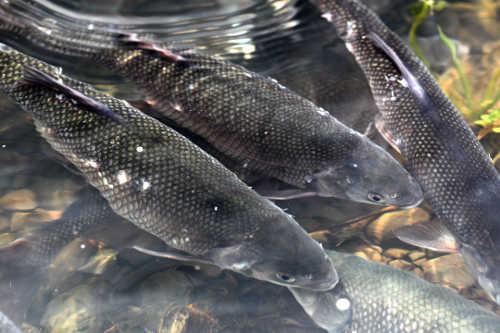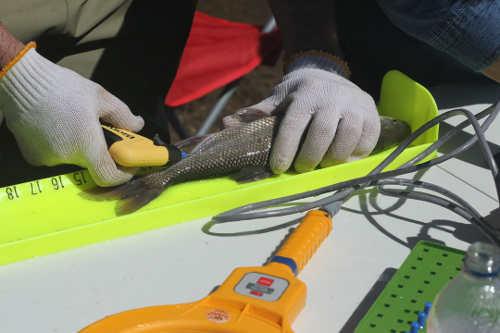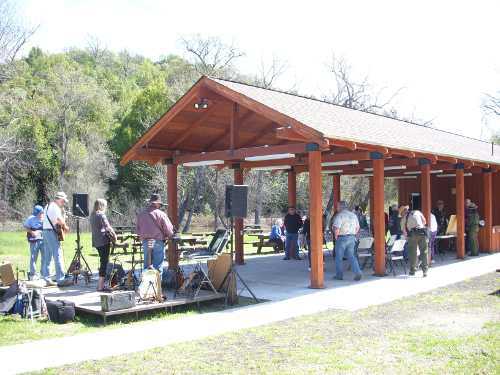- Elizabeth Larson
- Posted On
Hitch wind their way up local streams as part of annual migration

KELSEYVILLE, Calif. – There are many signs of spring's arrival in Lake County, and one of them – the spring spawning migration of the Clear Lake Hitch – is making a gradual comeback after many years when it appeared the fish was about to disappear into memory.
The hitch – known as the “chi” to the local Pomo peoples – is a Clear Lake native, has strong links to the Pomo cultural past and is well remembered by many people who have called the county home for the last several decades.
Sometime within the last 40 years the hitch started to decline, but more recently the fish has become a comeback kid of sorts, as it's the focus of tribal monitoring projects and a community group, the Chi Council for the Clear Lake Hitch, that's dedicated to the fish's preservation.
On Saturday, April 2, the Chi Council hosted a field trip for community members who wanted to watch the fish make their way up local streams for spawning.
Peter Windrem, a Chi Council member who led the tour, said he remembered the hitch in abundance in local creeks when he was a boy.
His childhood friend, Keith Petterson, who joined in the Saturday morning field trip, said the fish would sometimes be backed up into the little streams that ran through pear orchards.
A Chi Council map shows that most of Clear Lake's major tributaries at one time were home to hitch spawning runs.
But over the last several decades the hitch population has taken a precipitous decline, according to those who study the fish. Now, the hitch are mostly to be found in Kelsey, Adobe and Thompson creeks, although a small population is believed to live in Middle Creek near Upper Lake.
Windrem said the hitch is one of four fishes native to Clear Lake, the largest natural freshwater lake completely within California boundaries.
In addition to the hitch, those native species included the Clear Lake Splittail, now believed extinct – biologist Rick Macedo said the last sighting of one was in 1975 – the pikeminnow and Sacramento sucker.
Windrem said the sucker isn't seen much, but when it is he said it's a treat, because it's such a beautiful fish – golden in color, with black markings.
Where once the streams ran thick with hitch, today its numbers are far fewer, with little columns of them now making their way upstream to spawn.
Unlike salmon, however, the trip upstream isn't a long goodbye. Rather, once they spawn, it's back to Clear Lake for the hitch, with the possibility that they can return for several more years to come to repeat the process.
The reasons for the hitch's decline are many, according to Chi Council members and biologists.
On the first stop of the Saturday field trip, Windrem led the group to the bridge over Kelsey Creek at the west end of Kelseyville.
Looking down from the bridge, he showed a historical picture from 1899 of hitch crammed together in Kelsey Creek, taken from a vantage point about 100 yards down the creek from the bridge. At the time of that picture, the creek was more shallow, like an omelet pan, said Windrem.
“Historically, these streams have a very gradual grading,” he explained.
However, today the creek runs much deeper, with more defined banks.
In the 1960s and 1970s, gravel extraction operations on local creeks caused the level of Kelsey Creek to drop by about 30 feet, Windrem said.
At one point, there were concerns that the footing of the Kelseyville bridge over Kelsey Creek was being exposed so much that it might fall over, so Windrem said reinforcements were installed along its base to stabilize it.
But the changes to the creek's essential topography had more far-reaching consequences for the hitch, he said.
Whereas once the hitch could move easily along, with no serious changes in creek elevation, Windrem and Macedo, who took part in the Saturday tour, said the fish began to confront barriers they couldn't overcome during their multistage migration.
A fish ladder was added to an area of Kelsey Creek on the north side of the bridge, but the ladder's design favors salmonids, and, as Windrem pointed out, “Hitch don't jump.”
Macedo, considered a hitch expert, said that because they're not strong jumpers, hitch struggled to navigate both the ladders and the streams when the elevations become more steep.
He suggested the crossing under the Kelseyville bridge could be vastly improved for hitch if a trench was dug between the bridge's footings.
Other changes to streams and water resources play a part. Retired state Fish and Game biologist Jim Steele said, “The game is over when you get a reservoir.”
When asked if he remembered a point when the hitch population began to drop off, Petterson said, “I think it's just been a gradual change.”
On the field trip's second stop, at the Bell Hill low water crossing on Adobe Creek, Macedo said needed repairs at the crossing – particularly lowered culvert openings – benefited the fish, allowing them to pass easily pass through to a small area of rapids.
Good-sized clusters of the fish could be seen pooling in various areas around the crossing, and Macedo and Steele waded into the stream to catch a few hitch to show to the group traveling along on the trip.
Wearing a backpack device that some of the tour members said reminded them of equipment in “Ghostbusters,” Macedo used a long pole with a mesh square at one end that was attached to the backpack to mildly stun the fish in order to catch a few to put in a bucket of water.
Macedo called the fish – about a foot in length – “exceptionally large.”
The field trip goers gathered around to take a closer look at the silver-colored fish which, as they started to come out of their brief stupor, slapped disapproving tails on the insides of the buckets.
After just a few minutes in the bucket, Macedo carried them around the rapids and deposited them in a still pool so they could resume their trip upstream.

Research filled with new discoveries
For all of science's power to collect data and expand understanding, the hitch is still a fish largely surrounded by mystery.
“Everything that we learn about this fish is completely new,” said Paula Britton, environmental director for the Habematolel Pomo of Upper Lake.
Britton has been part of a study of the fish that's now in its third year.
For the county's tribes, the hitch historically was an important food source, with its spring spawning runs providing tribes with a critical harvest.
Today, the tribes aren't engaged in catching the fish for food, but rather for research, with a view to preserving it.
The US Fish and Wildlife Service granted Habematolel, Big Valley and Robinson Rancheria grants to study and tag the fish, now a “species of special concern,” Britton said.
Britton said the hitch project is the only one that doesn't involve an endangered species, and competition for funding is intense.
On Saturday, Britton was part of a team tagging the fish on a narrow portion of Thompson Creek off of Highland Springs Road, between Lakeport and Kelseyville.
The previous day they tagged 76 hitch in four hours, she said.
In about 45 minutes Saturday morning, they tagged 14 more, and Britton said they were planning to continue their work throughout this week and, possibly, into the coming weekend.
The fish – which must be 1 pound before they'll be tagged – were caught, put into a large cooler with water and a mild sedative to calm them. The fish were then handed to biologist Erik Ringelberg, who measured them and looked for anomalies like parasites, bird strikes and other injuries.
Ringelberg then handed them over to Britton – who was keeping the statistics – who then weighed them before putting them into another cooler filled with water with added oxygen to help the fish recover from the anesthetic.
“They're pretty amazing little fish,” said Britton.
Part of Habematolel's effort includes restoration on Middle Creek, including improving weirs there, she said.
The equipment being used to track the hitch allows researchers to follow the hitch's movement in the creeks, mostly on Adobe Creek, said Ringelberg.
However, they can't currently track what the fish do when they ultimately return to Clear Lake. Ringelberg said another proposed project would pursue tracking them in their lake home.
All of this carefully pursued research is adding to knowledge of the fish, but raising yet more questions that still haven't been answered, such as if the fish return to their natal streams, much like salmon do, he explained.
One of the surprising findings of the research, said Ringelberg, is that the fish, if they meet obstructions while passing through streams, will attempt to burrow through the streambed to get around the barriers.
Ringelberg said a requirement of Habematolel's grant is that the information be reported. Among the entities they report to are the California Natural Diversity Database.
Exploring the causes of the decline
The hitch is known to scientists as Lavinia exilicauda chi. The fish is the only species reported to be within the genus Lavinia.
University of California, Davis biologist Dr. Peter Moyle's seminal work, “Inland Fishes of California” discusses the fish in detail. It's an important book that Macedo keeps with him, pulling it out on Saturday to show to those on the tour interested in the hitch.
Moyle is a much respected scientist who is considered an expert on anadromous fish – those that migrate from salt water to fresh water for spawning – and whose knowledge and opinion have been called upon in studies on the Bay-Delta and the state's larger water issues.
In a 2009 e-mail exchange with Lake County News, Moyle said that he believed there was no question the hitch's numbers have declined, although the evidence is largely anecdotal.
The hitch and splittail were historically the lake's main plankton-eating fish, and had an enormous food supply, in addition to also eating the Clear Lake gnat, he said.
Moyle, who worked in Lake County in the 1970s, recalled seeing hundreds of spawning fish at “virtually any stream with water in it,” including drainage ditches of fields near Seigler Creek which he estimated was as many as 15 miles from Clear Lake.
Moyle attributed the fish's population decline to three main causes.
They included loss of spawning habitat, with streams being “increasingly channelized, dewatered, altered with barriers, and otherwise made inhospitable to hitch, including making them more vulnerable to predation, human and non-human.” He added that the hitch “have survived mainly because they spawn so early, the eggs hatch quickly, and the larvae wash into the lake.”
The second cause Moyle identified was loss of rearing habitat, particularly tules and marshes. He said that the larval hitch appear to benefit from being reared among tule stems, which protects them from predators like silversides and provides them with abundant microscopic food sources like rotifers, a tiny aquatic animal.
Moyle said the third – and probably most important – cause is the introduction of alien species into Clear Lake, including silversides and threadfin shad that compete with hitch for important food sources like zooplankton and which he believed also prey on the larvae and small juveniles.
The Florida largemouth bass for which the lake has become known are what Moyle called “a voracious predator” on larger hitch, which also are preyed upon by three species each of catfish and sunfish, and mosquitofish.
He estimated that huge fluctuations in shad numbers should have an impact on hitch populations both by periodically depleting food supplies and by allowing predator populations such as grebes to build up before the crash.
Moyle concluded, “It is evident that the Clear Lake hitch get hammered throughout their life cycle. It is a bit of miracle that they have persisted despite all this. Their decline makes the work of the Chi Council extremely important. Without active protection and management, the hitch will disappear.”
To learn more about the hitch, visit the Chi Council's Web site, http://lakelive.info/chicouncil/ . The group next meets at 3:30 p.m. Wednesday, April 27, at the Lake County Agriculture Center, 883 Lakeport Blvd., Lakeport. The public is invited to attend.
E-mail Elizabeth Larson at This email address is being protected from spambots. You need JavaScript enabled to view it. . Follow Lake County News on Twitter at http://twitter.com/LakeCoNews , on Facebook at http://www.facebook.com/pages/Lake-County-News/143156775604?ref=mf and on YouTube at http://www.youtube.com/user/LakeCoNews .















